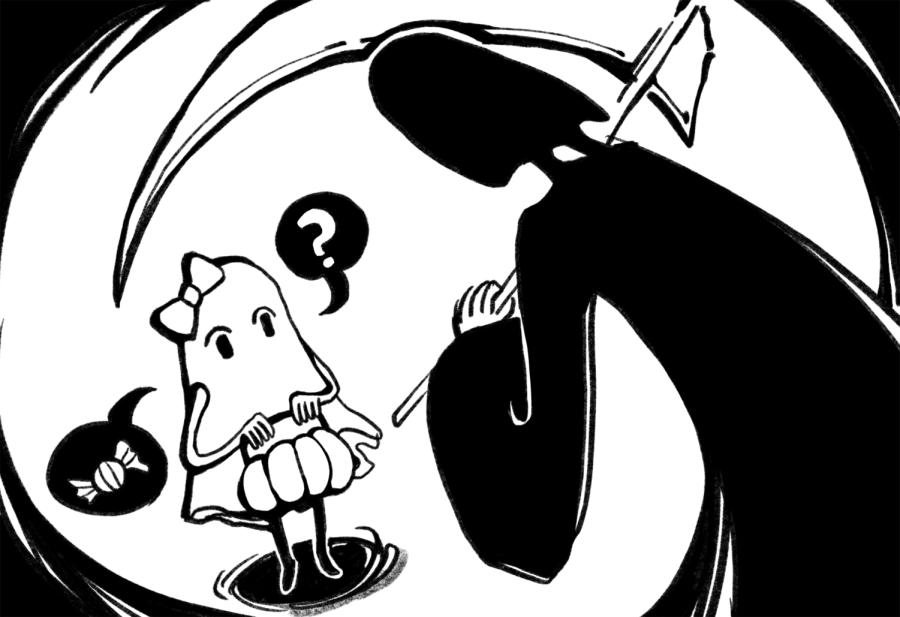Hidden horrors of the haunting holiday Halloween
STRANGER DANGER: The trick-or-treating season has more devious tricks than delectable treats.
October 31, 2022
‘Twas the night of Oct. 31, and children were out and about, squealing with joy as they bounced from house to house tricking in exchange for treats.
Lurking in the bushes, however, were people dressed in black hoods waiting to inflict damage on the unsuspecting trick-or-treaters and adults handing out candy at their houses.
The tradition of Oct. 31 began over 2,000 years ago as the Celtic festival of Samhain. It was believed to be a day where the worlds of the living and dead became blurred and Celts would cause chaos: They damaged buildings, burned crops and sacrificed animals to their deities as a way to satisfy the ghosts that entered the world on All Hallows’ Eve.
This tradition traveled the world, and for centuries, Halloween was a day for causing havoc. But in the late 1800s, there was a social movement to remove grotesque items and celebrations from the holiday and turn it into a safer holiday for young children.
Wearing scary costumes also originates back to the Celts, who believed that wearing costumes scared away the demonic presences of Oct. 31. That tradition morphed into what it is today due to major costuming companies, the first being the Collegeville Flag and Manufacturing Company in the 1920s, who saw the commercial possibilities of encouraging children to ditch the traditional bedsheet-ghost and become their favorite fictional characters.
But despite the multitude of princesses and fairies and Avengers lining the streets, Halloween remains one of the deadliest holidays, as criminals still take advantage of Halloween to give out more tricks than treats.
The most common crime committed on Halloween is property crime. On average, 17% more crimes are reported on Halloween than any other day of the year, according to the Hartman Law Firm in New Jersey.
In recent years, there has also been a sharp increase in the amount of rape cases reported on college campuses on Halloween. In fact, the Northwest Arkansas Center for Sexual Assault has created a campaign entitled “My Costume is Not My Consent” to emphasize that provocative or revealing clothing does not equate to consent.
Additionally, there is an increased number of car accidents with children making up 18% of fatal car crashes. Pedestrians have a four times higher chance of being hit by a car on Halloween than any other day of the year, according to the Center for Disease Control and Prevention.
Halloween gives people anonymity and the confidence that they cannot be caught behind their scary ghoul mask and black drape. Coupled with headlines that could accompany their stories such as “Candy Man Murderer” or “Halloween Homicide” to make them go down in infamy causes an increase in gang violence, abductions, murder and rape.
Currently, a new type of fentanyl disguised as candy is circulating around social media, designed to attract younger users. It’s rainbow in color and nicknamed “skittles” or “sweet tarts” according to NBC News. On a night where all candies are brightly colored, it is wise to be wary of each piece you place in your candy collection and to inspect for any unusual holes in the bags.
Other ways to stay safe this Halloween include carrying a glow stick or flashlight so that cars can see you when crossing the street, keeping your head out of your phone and being aware of your surroundings and always tell a trusted adult where you are headed.
Halloween may be depicted as a night full of laughter and too-much-sugar, but the shadows behind the laughing Jack-O-Lantern reveal the true dangers of All Hallows’ Eve, dangers that can be traced back to its ancient origins.



![AAAAAND ANOTHER THING: [CENSORED] [REDACTED] [BABY SCREAMING] [SIRENS] [SILENCE].](https://thehowleronline.org/wp-content/uploads/2025/06/lucy-1200x800.jpg)

















































![AAAAAND ANOTHER THING: [CENSORED] [REDACTED] [BABY SCREAMING] [SIRENS] [SILENCE].](https://thehowleronline.org/wp-content/uploads/2025/06/lucy-300x200.jpg)



